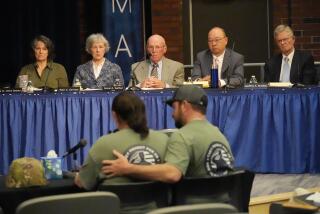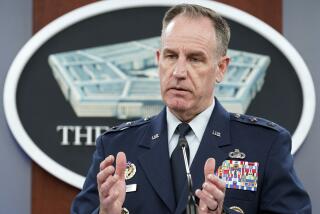Reserve Forces’ Arms Outdated, Report Says
- Share via
WASHINGTON — The Pentagon’s method of allocating weapons to the military reserves and the National Guard “has virtually guaranteed” that there will be difficulties if the organizations are called on to augment active-duty troops in combat, according to a Defense Department report.
The document, prepared by the Reserve Forces Policy Board, a semi-independent study group that reports to Defense Secretary Caspar W. Weinberger, criticizes a lack of organized decision-making in weapons allocation and in the assignment of missions and areas of responsibility for the reserves and National Guard.
The study, which has not been made public by the Pentagon, was made available to reporters by the Project on Military Procurement, a private organization that focuses on problems in military purchasing. It lends support to those who believe that the Pentagon has given insufficient backing and attention to the troops that would be called on to support active forces during a war.
Mix of Equipment Cited
Although the report did not deal specifically with which weapons should be shipped to reserve forces, the heart of the problems that it raised is the mix of equipment purchased for the 2.1 million active duty troops in the Army, Navy, Air Force and Marine Corps, compared to those available for the approximately 1 million in the reserves and National Guard.
“The Air Force relies very heavily on the contribution the Air National Guard would make in the event of a war,” said Michael Burns of the Business Executives for National Security, a nonpartisan trade association devoted to applying modern business practices to Pentagon operations. He said the Air Force estimates that 30% to 33% of the tactical fighter aircraft in a lengthy war would come from National Guard units.
Similarly, he said, “the Army relies very heavily on the Guard for combat support.” But he said National Guard units operate M-48 tanks, anti-tank and anti-aircraft weapons that are no longer in the active forces’ inventory. The reserves and National Guard do not stock sufficient spare parts, he said, and the active forces’ supplies for newer weapons are not compatible with the older equipment.
Training Problem
However, providing reserve and National Guard troops with the modern equipment that is going to troops on active duty introduces another problem: The newest equipment is extremely sophisticated and requires many hours of training for troops to become proficient in its use. Troops on active duty may have sufficient time for such training, but reservists on duty one weekend a month and then two weeks during the summer cannot be properly prepared, critics have said.
Army Maj. Pete Wyro, a Pentagon spokesman, said that the report had not been “through all the people who were supposed to make comments on it” and that the Pentagon was not ready to release it or comment on it. But he said that “we disagree with some of the indications.”
Wyro said that efforts have been made to modernize the reserves and National Guard and that, according to James Webb, the assistant secretary of defense for reserve affairs, $17 billion has been spent on this effort in the last two years.
Longstanding Problem
The Reserve Forces Policy Board completed its report in December. Its conclusions draw attention to a longstanding difficulty faced by the non-active-duty units of the U.S. military: gaining a sufficient share of the defense budget as well as the attention of the military bureaucracy.
The reserves, said Air Force Reserve Col. Frank McKeown, a Portland, Ore., dentist serving an extended tour at the Pentagon, have been “fighting to be recognized as combat-capable folks.”
The reserves and National Guard, which together received 4.9% of the defense budget two years ago, are expected to continue to get about 5% of the Pentagon budget through fiscal 1989.
More to Read
Sign up for Essential California
The most important California stories and recommendations in your inbox every morning.
You may occasionally receive promotional content from the Los Angeles Times.













